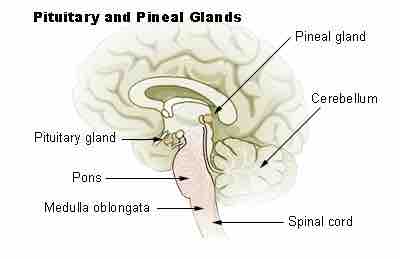The medulla oblongata is the lower half of the brainstem. In discussions of neurology and similar contexts where no ambiguity will result, it is often referred to as simply the medulla. The medulla contains the cardiac, respiratory, vomiting, and vasomotor centers and regulates autonomic, involuntary functions such as breathing, heart rate, and blood pressure.

The Brain Stem with Pituitary and Pineal Glands
Medulla oblongata labeled at bottom left, in relation to the pons, pituitary gland, spinal cord, pineal gland and cerebellum.
The medulla is often divided into two parts:
- An open or superior part where the dorsal surface of the medulla is formed by the fourth ventricle.
- A closed or inferior part where the metacoel (caudal part of fourth ventricle) lies within the medulla oblongata.
Structure of the Medulla Oblongata
The region between the anterior median and anterolateral sulci is occupied by an elevation on either side known as the pyramid of medulla oblongata. This elevation is caused by the corticospinal tract. In the lower part of the medulla, some of these fibers cross each other, thus obliterating the anterior median fissure. This is known as the decussation of the pyramids. Other fibers that originate from the anterior median fissure above the decussation of the pyramids and run laterally across the surface of the pons are known as the external arcuate fibers.
The region between the anterolateral and posterolateral sulcus in the upper part of the medulla is marked by a swelling known as the olivary body, caused by a large mass of gray matter known as the inferior olivary nucleus.
The posterior part of the medulla between the posterior median and posterolateral sulci contains tracts that enter it from the posterior funiculus of the spinal cord. These are the fasciculus gracilis, lying medially next to the midline, and the fasciculus cuneatus, lying laterally.
The fasciculi end in rounded elevations known as the gracile and cuneate tubercles. They are caused by masses of gray matter known as the nucleus gracilis and the nucleus cuneatus. Just above the tubercles, the posterior aspect of the medulla is occupied by a triangular fossa, which forms the lower part of the floor of the fourth ventricle. The fossa is bounded on either side by the inferior cerebellar peduncle, which connects the medulla to the cerebellum.
The lower part of the medulla, immediately lateral to the fasciculus cuneatus, is marked by another longitudinal elevation known as the tuberculum cinereum. It is caused by an underlying collection of gray matter known as the spinal nucleus of the trigeminal nerve. The gray matter of this nucleus is covered by a layer of nerve fibers that form the spinal tract of the trigeminal nerve.
The base of the medulla is defined by the commissural fibers, crossing over from the ipsilateral side in the spinal cord to the contralateral side in the brain stem; below this is the spinal cord.
Embryonic Development
During development, the medulla oblongata forms from the myelencephalon. The final neuroblasts from the alar plate of the neural tube produce the sensory nuclei of the medulla. The basal plate neuroblasts give rise to the motor nuclei.
Function of the Medulla Oblongata
The medulla oblongata controls autonomic functions and connects the higher levels of the brain to the spinal cord. It is also responsible for regulating several basic functions of the autonomic nervous system, including:
- Respiration – chemoreceptors
- Cardiac center – sympathetic system, parasympathetic system
- Vasomotor center – baroreceptors
- Reflex centers of vomiting, coughing, sneezing, and swallowing